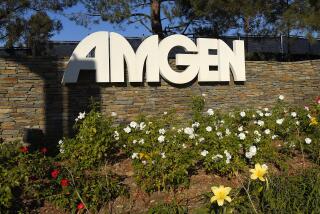Amgen Takeover Talk Fueled by Rise in Stock : Investment: Some analysts say the biotech giant, with its successful products, would be too costly an acquisition for all but the largest pharmaceutical firms.
- Share via
THOUSAND OAKS — Is biotechnology giant Amgen Inc. ripe for a takeover?
The recent jump in Amgen’s stock price “would indicate that some people are asking that question,” said Jim McCamant, editor of the Medical Technology Stock Letter in Berkeley.
But many analysts consider an acquisition of Thousand Oaks-based Amgen, the world’s largest and most profitable biotechnology concern, unlikely. “In the pharmacy business, companies don’t get acquired very often unless they want to,” McCamant said, because scientists might leave after a buyout. And Amgen’s chief executive, Gordon Binder, has previously said he doesn’t want the company sold.
The run-up in Amgen’s stock, along with similar gains in the stocks of other pharmaceutical and biotech companies, came after the announcement last week that Switzerland’s Roche Holding Ltd. would acquire Palo Alto-based Syntex Corp. for $5.3 billion, creating the world’s fourth largest drug firm.
The deal has fueled speculation that more pharmaceutical industry consolidation would follow. Stocks in that industry have been battered in the past year due to concern that health-care reform would include drug price controls.
Since May 2, when the Roche-Syntex deal was announced, Amgen’s stock has risen from $40.50 a share, to Monday’s closing price of $43.13. But that is well below Amgen’s peak of $77.75 a share in December, 1992. And Amgen’s market value, now about $5.8 billion, is still a bargain compared to the princely $10 billion it once commanded.
The recent increase in Amgen’s stock price could also reflect an awareness that some drug and biotechnology stocks are undervalued after their long pounding, analysts said. And in a favorable sign for the industry, last week the Clinton Administration indicated it would not oppose keeping price restrictions on “breakthrough” biotechnology drugs out of any health-care legislation.
Amgen would be a tempting takeover target because the patents on its two blockbuster biotechnology drugs, Epogen and Neupogen, don’t begin expiring for another 10 years. But that’s also a reason Amgen wouldn’t be as vulnerable to a takeover as Syntex was, analysts said. Syntex lost patent protection in December on its leading product, the arthritis treatment Naprosyn.
And to pay a premium similar to what Syntex shareholders are to receive, a suitor for Amgen would have to bid $8 billion to $9 billion, said analyst David Stone at the investment firm Cowen & Co. in Boston. Only a few of the world’s largest drug concerns, such as Merck & Co. or Eli Lilly & Co., could contemplate an acquisition of that magnitude. According to recent news reports Lilly considered a run at Amgen, but passed because it would be too costly.
However, one factor that would work against Amgen in an unfriendly takeover attempt is that only 3% of its stock is owned by current, or former, Amgen executives and directors.
Despite concerns over a slowing of Amgen’s earlier red-hot growth, the company’s profits keep rising. In 1993, Amgen earned a record $383 million on $1.3 billion in revenue. In the first quarter of this year, its profit rose 5%, to $93.5 million on a 17% rise in revenue, to $364 million.
Amgen also throws off a lot of cash. Value Line estimates Amgen’s cash flow this year at $462 million.
The two drugs that have fueled Amgen’s growth showed solid sales gains in the first quarter. Sales of Epogen, which fights anemia in dialysis patients by boosting red blood cell production, rose 20% from a year earlier. Neupogen, Amgen’s infection-fighting drug that stimulates white blood cell production, showed a 15% sales increase.
Amgen is hoping to find a third breakthrough drug--and spent a record $255 million last year in research and development--but so far all its prospects are in early stages of development.
McCamant suggested that Amgen might itself buy another, smaller biotech firm. Such a company might have a promising product, but a shortage of cash needed to endure the lengthy and costly process of bringing a drug to market.
*
Amgen’s Binder declined to be interviewed regarding the recent takeover speculation, or whether Amgen would be interested in buying another firm.
Amgen’s strategy so far has been to enter arm’s-length development deals and joint ventures with other companies in its quest for a new product, and in recent months it has announced a series of licensing and research agreements. Last month it made an equity investment in Alanex Corp., a San Diego start-up firm with whom Amgen is collaborating to design small-molecule drugs for treating neurological disorders.
In March, Amgen announced a long-term research agreement with the Massachusetts Institute of Technology, and a collaboration with Los Altos start-up Amcell Corp. to develop cell-separation technologies that might be used to treat cancer and AIDS.
One treatment Amgen is developing with Regeneron Pharmaceuticals Inc. in Tarrytown, N. Y., has shown promise in early stages of testing. Called brain-derived neurotrophic factor, it is a protein that would be used to treat Lou Gehrig’s disease and other degenerative diseases of the nervous system. The first clinical trials with human patients began in October, and preliminary results are expected by the end of the year. The pre-clinical data “was very positive,” said Amgen spokesman David Kaye, although he cautioned against raised expectations. Even under the best of circumstances it would be at least three years before the drug could be marketed.
“Amgen’s biggest problem, having launched the biotech industry’s two most successful products, is what do they do for an encore,” Stone said.
More to Read
Inside the business of entertainment
The Wide Shot brings you news, analysis and insights on everything from streaming wars to production — and what it all means for the future.
You may occasionally receive promotional content from the Los Angeles Times.











